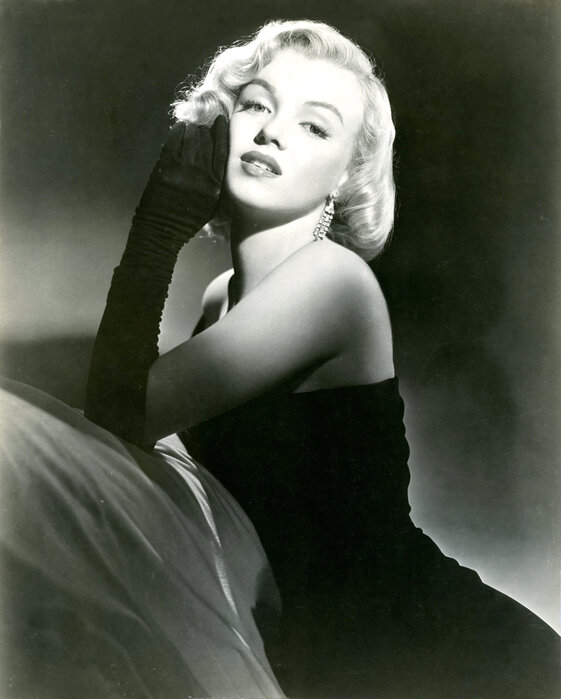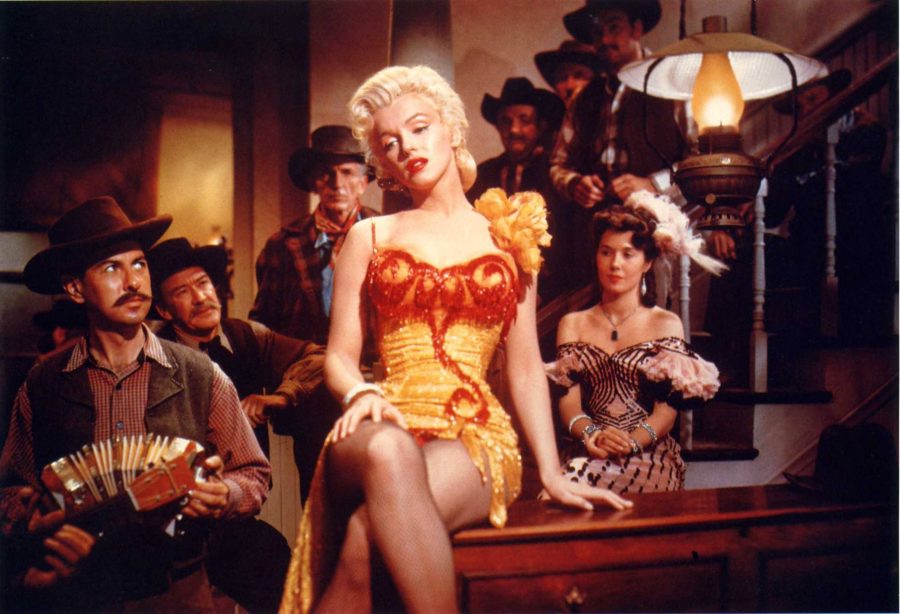Marilyn Monroe is a true depiction of the male gaze – she is defined by men. Her entire brand is being a model of what the perfect woman should be, specifically in her movie Gentlemen Prefer Blondes. She is blonde, skinny but also curvy, wears makeup, and wears ‘sexy’ outfits that flaunt her body, and make her look desirable.
ㅤ

Laura Mulvey (1975) began the perspective of the “male gaze”, which is a feminist theory that states that cinema narratives and portrayals of women in cinema are constructed in an objectifying and limiting manner to satisfy the psychological desires of men, and of patriarchal society. It looks at women in a way that diminishes them, but empowers men.
As of 2023, 84% of directors from the top 250 movies were men. The film industry is a male dominated industry, and thus most movies are from a male perspective.
Marilyn is a good example of the male gaze sexualising women that are seen as objects of the heterosexual male desire. She is often seen dressing provocatively, wearing short dresses, always having her neck on show, and is often seen flaunting her body through tight clothing. The director of the film always made her the object of desire – she was what women wanted to be, but more than that, what men wanted in an ideal woman. This, in turn, creates a fake consciousness about how women should think and behave, as these stories were told from the viewpoint of what a man wanted, and not what a woman should be.
ㅤ
The clip on the right is from the infamous Gentlemen Prefer Blondes (1953), when Marilyn and Jane walk down the stairs, you can see that the camera begins as a wide shot, but then immediately pans to have them both centered in the frame, more importantly, their breasts. You can see them sway as they walk, and then it shifts focus to men swooning over them, fantasising about wanting them.
This is the perfect example of women being objectified and sexualised by men, which is what the male gaze is in it’s entirety.
ㅤ

ㅤ
The clothing they wear is sparkly and enticing, it draws your attention, the V neck is provocative, the way the dress hikes up their thighs and clings to the rest of their body, they have bold red lipstick. It shows that women serve at the pleasure of men. It teaches women that they need to view themselves through the male gaze, and define themselves like it.
What is the criticism of the male gaze?
The male gaze promotes a patriarchal view on society, meaning that women are limited and diminished, promoting violence against women; an example being the Burger King advert, bringing back the popular phrase of “women belonging in the kitchen”.
This view means that women are subjected to an unrealistic representation of modern day society – it forces women to adhere to beauty standards that are unrealistic, when women should be themselves and promote natural beauty. The male gaze constricts this standard, and instead promotes a more sexualised view on what women should look like, which in turn leads to women being pressured to fit into the societal norm.
The male gaze is not the future, it is the past. Let it stay that way.
References
Media Studies (2024) The male gaze. Available at: https://media-studies.com/male-gaze/
Mulvey, Laura (1975) Visual pleasure and narrative cinema. Edition 1. Screen.
M. Lauzen, Martha (2024) The Celluloid Ceiling: Employment of behind the scenes women on top grossing U.S films in 2023. 26th Edition. Available at: https://womenintvfilm.sdsu.edu/wp-content/uploads/2024/01/2023-Celluloid-Ceiling-Report.pdf
Gentlemen Prefer Blondes (1953) Directed by: Howard Hawks. [Feature Film] United States: 20th Century Studios.


Your blog is a powerful critique of the male gaze, and your use of Marilyn Monroe in Gentlemen Prefer Blondes is an excellent example that vividly illustrates how women have been framed for male desire. Your analysis of the infamous staircase scene effectively highlights the objectification embedded in camera angles and framing.
One suggestion might be to explore how modern media has responded to this critique—are there contemporary films or shows that challenge the male gaze’s legacy? This could provide a compelling contrast and reinforce your conclusion that the male gaze should remain a relic of the past. Great work!
Hi Holly. your blog successfully incorporates Laura Mulvey’s ‘male gaze’ theory into specific texts by analyzing Marilyn Monroe andA Gentleman Loves a Lady, you have managed to incorporate Laura Mulvey’s theory of the ‘male gaze’ into a specific text in a brilliant way. Not only did you clearly explain the core concepts of the theory, but you also brought this embodiment of gendered power relations to life with detailed scene descriptions (e.g. how the camera captures Monroe’s body). I especially appreciated the way you used modern data (e.g., in 2023 ,84% of male directors in 2023) to extend the theory to the contemporary film and television industry in a way that makes your argument both academically deep and realistically relevant.
Additionally, I particularly like your final conclusion. The male gaze is the past, not the future, which is not only powerful, but also summarizes your argument well and creates a strong emotional resonance for the reader. However, I did have one thought while reading:Is it possible that Monroe is somehow capitalizing on the male gaze and achieving personal goals by catering to those expectations? Did her portrayal also challenge the social norms of the time to some degree? A little discussion of women’s initiative in this framing, or how modern female directors have reshaped these roles, might have rounded out your perspective. Overall, your blog demonstrates not only a deep understanding of theory, but also strong critical thinking and writing skills. It’s really great that your writing is both theory-backed and able to move the reader!